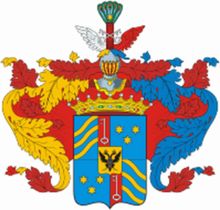Ewald von der Osten-Sacken
Ewald von der Osten-Sacken (* before 1682; † July 28, 1718 ) was Chancellor in the Duchy of Courland and Semigallia , member of the ducal councilor and district administrator of Pilten . He came from the German-Baltic noble family von der Osten-Sacken .
Life
Ewald studied at the University of Königsberg around 1682 , after completing his studies he embarked on a political career. From 1709 to 1718 he was Chancellor of Courland and from 1710 also Pilsen District Administrator . From 1714 he also acted as district administrator for the offices of Piltene and Dondangen in Courland .
Family and origin
The noble family von der Osten-Sacken was a Pomeranian noble family, which the Lower Saxon nobility came from and with the branch Osten-Sacken Baltic belonged to nobility. His parents were the chamberlain Johann Ulrich Freiherr von der Osten-Sacken (1630–1701), royal Pilsen district administrator and heir to Bathen and Lehnen, and Sophie Hedwig, born von der Recke from the Blieden family († 1680). His brother was the colonel ( Landgraviate Hessen-Kassel ) Johann Ulrich von der Osten (1674–1731), who was married to Benigna Elisabeth von Fircks (1694–1734). His son was Prince Carl von der Osten called Sacken (1726–1794). His sister Anna Sibylla was married to Dietrich Maydell the lord on Dondangen (Dundaga), she bequeathed Dundaga Castle to Carl.
Dundaga Castle
The knight's castle Dondangen, also known as Dundaga Castle, was initially owned by the hereditary lord Diedrich Maydell, who was married to Anna Sybilla von der Osten-Sacken. She was the driving force behind the construction, renovation and expansion of the castle . Since the marriage remained childless, the widow Anna Sybilla bequeathed the estate with the castle to her nephew Prince Carl. He initiated a further renovation and expansion. In 1766 a stone church was built (wooden churches were common). During the revolution in 1905 the building was burned down. It was rebuilt in 1909 according to the designs of the architect H. Pfeiffer. From 1926 the castle was used as a school and as an administration building.
Web links
- Baltic Historical Commission (ed.): Entry on Ewald von der Osten-Sacken. In: BBLD - Baltic Biographical Lexicon digital
- Gerlinde Kraus: Christiane Fürstin von der Osten-Sacken: an early capitalist entrepreneur and her heirs during the early industrialization in the 18th and 19th centuries. Century . In: Contributions to the company's history . tape 10 . Franz Steiner Verlag, 2001, ISBN 3-515-07721-9 , ISSN 1433-8645 , p. 31 (340 p., Limited preview in the Google book search - diploma thesis / dissertation).
- [4] Johann Gottfried Gruber and Johann Samuelersch , General encyclopedia of sciences and arts in alphabetical order , Verlag FA Brockhaus, 1836, original from the University of Minnesota , digitized December 18, 2014
- Johann Ulrich von der Osten called Sacken and Descendants. Entry on Geneall.net
- Ewald von der Osten-Sacken. Entry on Geneall.net
Individual evidence
- ↑ August Wilhelm Hupel , Der nordischen Miscellaneen 1.-28 Stück: materials for an öselschen nobility story, volumes 20-21 of Der nordischen Miscellaneen 1.-28 Stück, Verlag v. Hirschheydt , 1790, original from University of Michigan , digitized Sept. 28, 2007 [1]
- ↑ Dondangen, knight's castle and private estate in Courland , sung about by Jakob Friedrich Bankauu. (Pastor to Samiten, then to Dondangen, also Piltenschen Consistorial-Assessor, († 1724)) with some notes and an appendix. Dorpat, 1855. Printed by Heinrich Laakmann [2]
- ↑ Castle of Dundaga [3]
| personal data | |
|---|---|
| SURNAME | Osten-Sacken, Ewald von der |
| BRIEF DESCRIPTION | Chancellor in the Duchy of Courland and Semgallia, member of the ducal high council and district administrator of Pilten |
| DATE OF BIRTH | before 1682 |
| DATE OF DEATH | July 28, 1718 |

